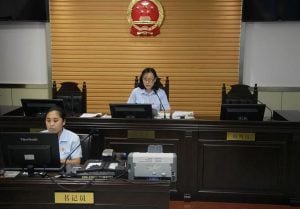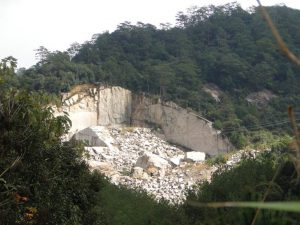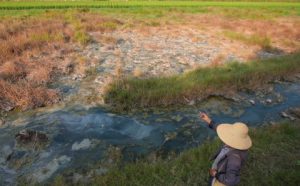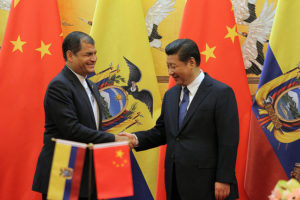China has seen a rapid growth in environmental public interest legal challenges since January 2015, when a revised version of the Environmental Protection Law (EPL) came into effect. Nearly 100 lawsuits have been filed by both NGOs and public prosecutors (or “people’s procurators”), and while many of these cases are still in process, of the ones that have been resolved almost all have been won or mediated.
The updated law is the result of a drawn out amendment process started in 2001 with the aim of strengthening the legislative tools to punish polluters. It marked significant progress in the area of public interest litigation in China.
So far lawsuits have mainly targeted polluting enterprises, but also some government departments. While Chinese Non-Governmental Organisations (NGOs) continue to face challenges in filing public interest lawsuits, the capacity for them to take on more major emitters is growing.
History
Some public interest lawsuits took place in China prior to the reform of the Environmental Protection Law in 2014, drawing legal basis from local laws. Some successful lawsuits were filed against local polluters with litigants including NGOs (notably the All China Environment Federation) as well as local public prosecutors.
One of the more dramatic verdicts came in Taizhou in eastern China in 2014 – just before the revised law took effect – when the Taizhou Environment Federation and Taizhou People’s Procuratorate successfully sued six chemical producers 160 million yuan (approximately US$26 million). How that money should be used remains a challenge. The prevailing idea is that funds should be set up at the local level and the money directed towards restoring the damaged environment.
Public interest litigation has now gained stronger legal grounding. The revision of the Civil Procedure Law in 2013 and the Environmental Protection Law in 2014 granted environmental NGOs that have been registered and operating for over 5 years the ability to sue polluters in the public interest. They are supported by a detailed judicial interpretation on civil environmental public interest litigation, issued by China’s Supreme People’s Court in early 2015. Also in 2015, the National People’s Congress approved a pilot project to allow certain people’s procuratorates to bring public interest cases against polluting enterprises and government officials and departments found to be in dereliction of duty.
Current Status
The passing of the revised Environmental Protection Law has resulted in a steady stream of public interest cases filed by NGOs and prosecutors throughout the country. These include cases filed by NGOs against individual polluters (e.g. Friends of Nature vs. Xie Zhijin and others), NGOs against local private enterprises (e.g. ACEF vs. Zhenhua Group), NGOs filing multiple lawsuits in response to a pollution incident (e.g. eight cases filed by China Biodiversity Conservation and Green Development Foundation (CBCGDF) in response to the Tengger desert pollution incident).
There have also been cases of prosecutors filing civil lawsuits against companies or individuals (e.g. Xuzhou People’s Procuratorate vs. Hongshun Co. Ltd.), as well as filing administrative lawsuits against government agencies (e.g. Qing County People’s Procuratorate vs. Qing County Environmental Protection Bureau).
The positive impact of public interest cases in China is beginning to be felt. Significant damages have been awarded in many cases. For example, damages in the case of ACEF vs. Zhenhua Group – China’s first major public interest case on air pollution – amounted to more than 20 million yuan (approximately US$3.2 million), sending a clear message to polluters of the risks of non-compliance.
Many defendants are also opting to settle public interest cases, either within court or outside of court, and anecdotal evidence suggests the risk of a public interest lawsuit has been effective in putting pressure on non-compliant companies. Several public interest cases have now made their way into the typical cases issued by Chinese courts as references for judges.
Challenges
However, challenges remain for both NGOs and prosecutors bringing environmental public interest cases. A relatively small number of the 700 NGOs in China which are qualified to file public interest environmental lawsuits have so far brought cases to the courts – only six NGOs have brought cases in 2016.
And despite clear rules about who can bring cases, last year some NGOs still faced obstacles in having their cases filed in local courts. For example, in the Tengger desert case, the first instance court rejected CBCGDF’s ability to sue based on a controversial reading of their articles of association (a document which defines the responsibilities of an organisation or its directors), a judgement which was ultimately overruled by the Supreme People’s Court. CBCGDF have since successfully filed eight lawsuits against the culpable polluters.
Also, for NGOs and prosecutors alike, establishing causation and estimating environmental damages can be difficult, particularly for air pollution cases or in cases where there are multiple polluters. In most cases the burden of proof falls on the plaintiff but in some cases the courts will commission their own assessment.
In ACEF vs. Zhenhua, for instance, the plaintiff attempted to assess air pollution damages based on operating cost, as allowed by the judicial interpretation on environmental public interest litigation. However, the court rejected this, opting instead for a ‘treatment cost estimate’ approach, a method that is difficult to apply accurately to damages from air pollution.
However, the most important obstacle to environmental public interest law is a lack of financial resources. Fees for lawyers and other costs can be a major hurdle for NGOs. For example, in ACEF vs. Zhenhua, the plaintiff incurred about 400,000 yuan (US$62,000) in fees, but the court rejected its claim to have the defendant pay these costs because the plaintiff had not yet paid the lawyer’s fees, which were dependent on the case being successful.
The issue of lawyer’s costs is really important. For comparison, the US practices one-way cost shifting whereby the NGO plaintiff’s lawyer’s costs can be recovered from a losing defendant, but a defendant cannot recover their costs from a losing NGO. Courts apply certain standards for what is considered reasonable compensation for NGO lawyers.
In European countries things vary wildly. Until recently in the UK, the potential costs associated with bringing a losing case were often prohibitive because defendants could claim tens of millions of pounds in legal fees if an NGO plaintiff lost a case. Environmental law group ClientEarth brought a complaint to the EU, and in 2012 the UK was convinced to change the rules and put a limit on these liabilities.
Trends
The Chinese government is actively promoting environmental public interest litigation, and has published a number of policy documents. For example, the Supreme People’s Court issued a “White Paper on Environmental and Natural Resources Adjudication” in July 2016, and will soon publish an official English translation. With active encouragement from the top court, it is likely that the ability for lower level courts to accept and effectively rule on environmental public interest cases will continue to improve.
1. Growing number of air pollution cases
According to statistics collected by Friends of Nature, around one fifth of the environmental public interest litigation cases filed in 2015 involved air pollution, with most targeting fixed source pollution. Following many successful verdicts or mediations among these cases, more air pollution cases have been filed in 2016. These include cases filed against automobile emitters (e.g. CBCGDF vs. Volkswagen, Friends of Nature vs. Hyundai) as well as point-source emitters. These cases have targeted air pollutants such as SOx, NOx, and dust.
2. Bigger polluters being targeted
In 2015, defendants consisted mainly of individuals and small enterprises but in 2016 more and more cases are being brought against multinationals and Chinese state-owned enterprises. Examples include lawsuits filed by CBCGDF against Volkswagen and Hami Coal Power Co., as well as Friends of Nature vs. Hyundai, Jilin Petrochemical and Anshan Iron and Steel. Cases against bigger polluters will have bigger impacts. Also, these cases are safer for the NGO bringing the case because large companies are less likely to resort to illegal intimidation tactics.
Conclusion
2015 was a year of largely successful experimentation, and this year we’re seeing bigger cases. We expect the impacts of environmental public interest litigation will continue to grow. New legislation and policies are likely to lend further support to NGOs seeking to bring cases. Courts around China are encouraged by the Supreme People’s Court approach to environmental cases. NGOs continue to gain experience, as well as confidence, and technical and financial resources to bring to cases.
As the number of cases grows and the penalties awarded increase, polluters around China will take note and become more pro-active in achieving compliance. Although environmental public interest litigation comes from a low starting point, it has grown faster than many expected. Let’s hope it will continue to develop.
This article was submitted to China Dialogue by Dimitri de Boer and Douglas Whitehead, consultants for environmental law group ClientEarth.







